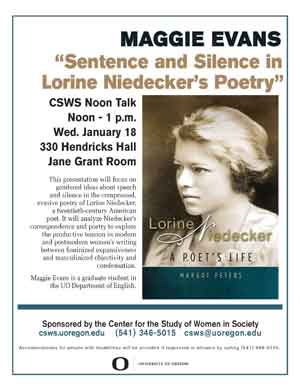Reprinted from the 2012 CSWS Annual Review (pp. 15-16)
Strategies of Silence in American Women’s Poetry
2011 CSWS Jane Grant Dissertation Fellowship winner studies the use of innovative forms in the work of Louise Niedecker and other twentieth-century women poets.by , PhD candidate, Department of English
The final lines of Marge Piercy’s “The Woman in the Ordinary” exemplify a familiar strain of contemporary American women’s poetry:
“In her bottled up is a woman peppery as curry, a yam of a woman of butter and brass, compounded of acid and sweet like a pineapple, like a handgrenade set to explode, like goldenrod ready to bloom.”
The poem celebrates the potential uncorking of a “bottled up” womanhood and laments the self-effacement of women who suppress their brassiness. It values the expression of repressed or devalued aspects of femininity, and the final similes of the poem depict this eventual expression as an explosive blossoming—both destructive and vital. The violent flowering of female expression is an image that resonates with the mainstream of feminist poetry. Indeed, feminist literary effort has largely focused on the recuperation and encouragement of writers whose voices have been systematically silenced. This has been an important goal, and it has helped readers to discover (or to remember) the work of many women writers. However, despite its usefulness, the conception of the creative work of women as a means of speaking out against oppressive silences has now become limiting: this concept cannot apprehend the silences that are endemic to poetic language, making it difficult to appreciate the strategic uses of silence that are central to many women’s poetic practice. As a result, women poets who favor leaving out rather than speaking out are sometimes relegated to the margins of literature. This is due to a masculinist literary history that makes them a footnote but also to a feminist narrative of finding voice that does not accommodate poems steeped in silence. My research seeks to complicate prevailing notions about speech and silence in women’s poetry to account for poems by women writers who resist language as well as those who triumphantly claim it.
Lorine Niedecker’s poetry is not widely known, in part because her work has been considered ancillary to the male-dominated Objectivist movement but also because her short poems, her refusal of narrative cohesion, and her obliquity make her an unlikely candidate for mainstream feminist reclamation. Niedecker (1903-1970) spent most of her life in rural Wisconsin, where she worked as a laborer while writing and publishing her poems. She was a reticent person who avoided publicity and kept her social and professional circles small. Perhaps it was this personal restraint that led Niedecker away from the confessional, talkative style of many of her contemporaries and toward terse poems like this:
“Something in the water like a flower will devour water flower”
 The poem is cryptic, briefly describing an unnamed “something” that “will devour.” The information the poem provides about its purported subject, “something in the water,” is strictly circumscribed. While the simile, “like a flower,” evokes an aquatic blossom, the only certain thing is that the “something” is not a flower; it is only like one. Further, because of the grammatical ambiguity of the first three lines, the phrase “like a flower” could apply to the noun “something,” the prepositional phrase “in the water,” or the verb “devour.” Thus, the something could simply be like a flower, it could be located in the water like a flower, or it could devour like a flower does. In this final instance, the isolated nouns of the last two lines, “water” and “flower,” may be the things that a flower, and by analogy the “something,” devours. But they may also simply be ambient description, setting the scene for the action of the first three lines.
The poem is cryptic, briefly describing an unnamed “something” that “will devour.” The information the poem provides about its purported subject, “something in the water,” is strictly circumscribed. While the simile, “like a flower,” evokes an aquatic blossom, the only certain thing is that the “something” is not a flower; it is only like one. Further, because of the grammatical ambiguity of the first three lines, the phrase “like a flower” could apply to the noun “something,” the prepositional phrase “in the water,” or the verb “devour.” Thus, the something could simply be like a flower, it could be located in the water like a flower, or it could devour like a flower does. In this final instance, the isolated nouns of the last two lines, “water” and “flower,” may be the things that a flower, and by analogy the “something,” devours. But they may also simply be ambient description, setting the scene for the action of the first three lines.
Ultimately, the poem undermines its own sparse imagery, characterizing the relationship among its objects as devouring but refusing to articulate exactly what devours what.
The poem’s formal silences—particularly brevity and omission—intensify the undecidability of its meaning. Its extreme brevity is representative of Niedecker’s aesthetic of silence. In particular, the shortness of the individual lines works to separate the objects of the poem, interrupting the connections the syntax suggests. The phrase “Something in the water like a flower will devour” establishes grammatical relationships, however uncertain, but the curtness of the lines suppresses those interactions in favor of self-contained phrases. This brevity also creates more white space around the lines—further emphasized by the extra spaces surrounding the final single-word lines—which visually isolates the individual lines of the poem, pulling against the relationships implied by the sense of the words. In addition to brevity, Niedecker uses strategic omissions to resist language. The poem refuses to provide narrative context that might clarify the significance of its images, and it erases the conjunctions and punctuation that would integrate its short lines into a sentence with determinate grammar and meaning. Any punctuation would inevitably limit the possible readings of the poem, resolving at least some of the ambiguity. For instance, even the simple addition of a final period would convert the poem into a single sentence, requiring the integration of “water” and “flower” into the grammar of the previous phrase, foreclosing the possibility that they exist independently. And certainly the inclusion of conjunctions or prepositions, especially in the final two lines, would more strictly delineate the proliferating meanings. The poem omits these elements, silencing important relational functions of language like subordination and coordination and leaving the interactions between its objects indeterminate. The poem refuses to say what its mysterious “something” is, leaving it to float beside “flower” and “water” in a wash of uncertain connections.
The use of formal silences to destabilize linguistic relationships among objects is central to Niedecker’s poetics because she wanted to acknowledge the separate identity of objects. The silences in a poem like “Something in the water” allow its objects to escape both poet and reader and remain unfixed by language, slippery and resistant. Further, since women have been the poetic object par excellence, explored by male subjectivity, Niedecker’s silences have feminist implications: they are the tools of a protective poetics that seeks to represent without appropriating, refusing to transgress the boundaries of objects and insisting on the limits of the poet’s power to dictate an object’s meaning. Her quiet aesthetic of omission and its recognition of the otherness of its objects is a form of feminist resistance entirely distinct from a poetry of explosive blossoming.
My work on silence in Niedecker’s poetry is part of a more wide-ranging project exploring how 20th-century American women use innovative forms to manage conflicting desires for speech and silence. I argue that women poets often seek both to extend and to limit language, and I investigate how their poetic experiments allow them simultaneously to achieve these contradictory goals. My hope is that the finished work will be useful to literary scholars studying the complexities of form in American women’s poetry. Further, I hope it will contribute to the growing conversation in women’s studies seeking critical methods responsive to the variability and complexity of women’s experiences and their ways of representing, or refusing to represent, those experiences. ■
— was awarded the 2011 Jane Grant Dissertation Fellowship from CSWS.
Works Cited
Niedecker, Lorine. “Something in the water.” Lorine Niedecker: Collected Works. Ed. Jenny Penberthy. Berkeley and Los Angeles, CA: U of California P, 2002. 202.Piercy, Marge. “The Woman in the Ordinary.” Literature and Society: An Introduction to Fiction, Poetry, Drama, Nonfiction. Ed. Pamela Annas and Robert Rosen. 3rd ed. Upper Saddle River, NJ: Pearson, 1999. 373.


